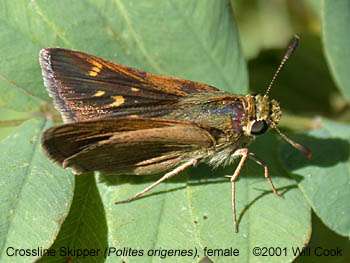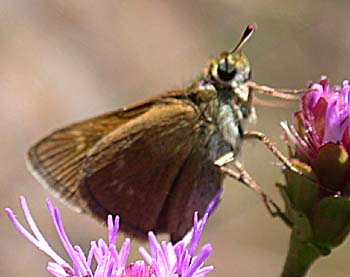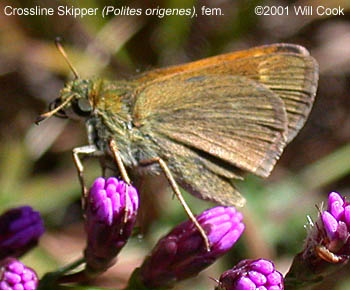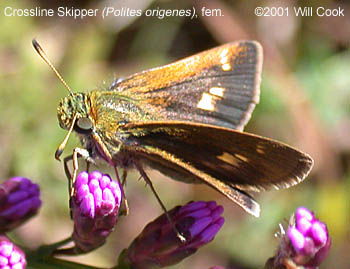Crossline Skipper (Polites origenes) or Tawny-edged Skipper (P. themistocles)?
 
|
This female looks a lot like Glassberg's photo of a female Tawny-edged Skipper. We thought it might be a Crossline because the upperside of the hindwing had a broad dark border with a touch of orangish inside. Weymouth Woods, Moore Co., NC, 3 October 2001. |
 
| This female was photographed in northern Moore Co., 7 October 2001. |
Discussion From Leps-L
Subject: Polites origenes or P. themistocles?
Date: Tue, 30 Oct 2001 11:33:44 -0500
From: Will Cook (cwcook@duke.edu)
Newsgroups: sci.bio.entomology.lepidoptera
Anyone care to give an opinion on these two individuals?
http://www.duke.edu/~cwcook/pix/xlineskipper.html
I've gotten two expert opinions so far - one calls them both Crossline
Skippers (P. origenes) and the other calls them both Tawny-edged
Skippers (P. themistocles)...
Thanks,
--
Charles W. "Will" Cook w 919-660-7423
http://www.duke.edu/~cwcook cwcook@duke.edu
Biology Dept., Duke Univ., Box 90340, Durham, NC 27708
------------------------------------------------------
Date: 30 Oct 2001 11:21:25 -0800
From: drdn@mail.utexas.edu (Chris J. Durden)
I think you have one female of each.
The first P. themistocles, with FW subapical spots forming a horns-out crescent;
cubital spot forms a small chevron; yellow dot in cell.
The second P. origenes, with FW subapical spots in a straight line;
cubital spot large, pale and squared.
.......................Chris Durden
------------------------------------------------------
Date: 30 Oct 2001 12:00:51 -0800
From: warrena@bcc.orst.edu (Andrew Warren)
I am leaning towards P. themistocles females for both individuals. Don't
know for sure but does P. origenes fly as late as October in that part of
the US?
Andy Warren
------------------------------------------------------
Date: 30 Oct 2001 13:53:11 -0800
From: grishin@chop.swmed.edu (Nick Grishin)
I am voting for *P.themistocles* on both pictures. Confidence: high.
nick
------------------------------------------------------
Date: Tue, 30 Oct 2001 17:11:41 -0500
From: Will Cook (cwcook@duke.edu)
Andrew Warren wrote:
> I am leaning towards P. themistocles females for both individuals. Don't
> know for sure but does P. origenes fly as late as October in that part of
> the US?
There's no difference in their flight charts here - both disappear by
the end of October; P. origenes is much more common than P. themistocles
here at any time of year. Reference: Notes on the Butterflies of NC
http://www.ncsparks.net/butterfly/nbnc.html
------------------------------------------------------
Date: 30 Oct 2001 14:02:19 -0800
From: Norbert.Kondla@gems3.gov.bc.ca (Kondla, Norbert FOR:EX)
I have no personal experience with origenes so do not know the difference
and hence cannot vote:-) But I would like to understand the differences so
it would be helpful if those who think both are themistocles could explain
their reasons (what are the visible characters?)as Chris did for going with
two species.
------------------------------------------------------
Date: 30 Oct 2001 19:06:42 -0800
From: gochfeld@EOHSI.RUTGERS.EDU (Michael Gochfeld)
I vote for P.themistocles (Tawny-edged) for number 2.
The unmarked hindwing and the strong tawny bar on the FW seem indicative.
In life there is a "jizz" to the Tawny-edged that's hard to explain (jizzes are
by nature hard to describe).
I'll abstain on the first photo. The slightly dotted pattern on the ventral
hindwing can occur in
Tawny-edged although I can't recall feeling confident identifhying of that
variation here in NJ.
It is more typical of P. origines. Likewise the not-so-strong tawny bar on the
forewing in a creature that's
not especially worn, doesn't strike me as P.themistocles.
So if I had voted on both I would have reached the opposite conclusion from
Chris.
Of course there may be different variation patterns between NJ, NC and TX.
If I understood Chris correctly, the three subapical spots on the dorsal FWof
the first individual shows that the outermost spot is
longer than the other two. Is this a significant mark for P.themistocles? It
shows up in some books but not others and doesn't seems consistent.
Of course, there's always a chance that book photos are mis-identified.
------------------------------------------------------
Date: 30 Oct 2001 17:29:40 -0800
From: jeff@primus.ca (Jeff Crolla)
I think they are both themistocles. On the ventral photo of the Oct 7 one,
the olive tinge to the ventral HW and outer FW , the bright orange along the
ventral FW costa, and the small-winged (to my eye) look with a
proportionally broad fringe all look more like themistocles. The cubital
spot does look more like what I would expect for origenes (slightly concave
on both sides) but based on the extensive orange costa and the ventral view,
I still lean toward themistocles.
In the first photo of the Oct 3 one the very yellow color of the FW spots
(even when fresh I think these are a lighter cream in origenes) and the
shape of the cubital spot (concave on the outside, convex on the inside
making a chevron like Chris Durden said) looks typical of themistocles,
although in this case the spot is a little narrow. The small cell spot on
the FW Chris Durden mentioned is sometimes shown by origenes also.
Jeff Crolla
------------------------------------------------------
Date: 31 Oct 2001 00:52:21 -0800
From: gatrelle@tils-ttr.org (Ron Gatrelle)
There is more than meets the eye with these two specimens and these two
species. These two have been on my taxonomic back burner for more than a
couple of decades. When living in Pensacola Florida in the late 1960's
either Cliff Ferris or Don Eff put me onto the fact that there are two
subspecies of "themistocles" (one of which remains undescribed -- or at
least unrecognized) -- just as there are two subspecies of origenes. (See
Bflys of the Rocky Mountain States by Ferris & Brown, 1981). There are
several interesting problems here especially with themistocles re the older
names. I'll save all that for another post if there is interest..
For those who live out west and up north (from us here in the deep south),
both of these species are much more fulvous there then they are here. Now
"here" does not necessarily mean south central North Carolina where these
specimens where found and photographed. I am still learning that North
Carolina is a lot more "northern" in its species than down here is the
lower coastal area of South Carolina. The only half way decent pictures of
themistocles from the deep south I know of are those found in Bflys of
Georgia by Harris,1972, plate 8 figs. 1 & 2. Those pictures are not too
dark. They are very accurate. I have themistocles from SC., GA, FL
panhandle and coastal AL. Some of these males are almost entirely void of
fulvous and many females have no orangish at all on the upper edge of the
forewing - though most have an orange highlight to the costal edge of the
ventral forewing..
The pictures of origenes in the same book and on the same plate figs. 3& 4
are also accurate and show how dark that species often is in the deep
south. Origenes females in this far southern area rarely have any fulvous
anywhere - less so than themistocles. In many origenes and themistocles
specimens in this southern range the only way to tell these females apart
is that origenes are usually much larger than the themistocles - and also
by male associations.
(A character which is supposed to differ between origenes and themistocles
females but that is not visible on these specimens is recorded in Colorado
Butterflies by Brown, Eff, and Rotger. "In case of doubt look at the third
vein from the inner margin of the fore wing, the upper cubital branch. It
arises nearer the fourth vein than the second vein on rhena [origines
rhena] and mid way between the two on themistocles. These veins can be
seen best on the underside of the wing." But, this only works on
collected and mounted specimens.)
Now, NC should be the area where the lighter northern form is blending to
the southern very dark forms. Thus to find a specimen with as much orange
as is on the second female means it is absolutely a themistocles - for even
in that NC area origenes females would not have anywhere near that much
fulvous. I attribute the lighter color of the central spot to "glare".
Note the white glare on the thorax where the scales are worn off. Also in
the deep south both themistocles and origenes have more creamy FW spots.
The top specimen is the tough one. The main thing on it that I see that
could indicate origenes are the spots on the HW. However, some
themistocles have these also. The upper FW costal orange just looks like
too much to be a southeastern US origenes. The central spot is odd shaped
but too fulvous for origenes. I go with themistocles for this too. BUT
this could be origenes. It might be best to call this indeterminate.
Ron
------------------------------------------------------
Date: 31 Oct 2001 04:24:35 -0800
From: gochfeld@EOHSI.RUTGERS.EDU (Michael Gochfeld)
Ron, thanks for the detailed discourse. It makes my absention on #1 easier to
live with.
But a question?
If one looks at a long series from the same place (any place) of either of
these species, how much do the shape of the spots on the dorsal FW vary.
The ones in the photo don't closely match any of my local photos or book
photos. How close is close enough?
M. Gochfeld
------------------------------------------------------
Date: 31 Oct 2001 11:14:54 -0800
From: warrena@bcc.orst.edu (Andrew Warren)
Hello,
Excellent review, Ron! I agree that themistocles is a nasty can of worms.
Series of Colorado material are clearly larger, paler, and better marked
in general when compared to E OKLA, TENN, and GA series (that I have). NY
material is slightly more fulvous than the E US material I have. The
total distribution of the CO phenotype is unclear to me; S UT material is
even larger still with more extensive fulvous areas. Far western
populations (N CA, BC and vic., probably E WA and ORE) are Freeman's ssp.
turneri (this has been ignored by most authors); these are smaller than
other western material with darker fulvous markings, in some ways
resembling the SE US phenotype. Old (1940's) and rare specimens from NE
ORE could represent another separate phenotype (this is another issue
since these pops. need to be rediscovered and possibly only 1 specimen
is extant).
More to the point, I agree with Ron that the very best way to
differentiate female themistocles and origenes is size (this seems
constant wherever the two species co-occur). I had called the two
individuals in the photos themistocles mostly because I did not realize
origenes had such an extended fall flight in the SE USA. I admit that I
could not be sure what species the top photo (the "tricky" one in my
opinion) is without seeing the specimen spread on a pin. It does seem a
bit too fulvous to be an origenes, however, as Ron noted. I still lean
towards themistocles for both of them (based mostly of the extensive
fulvous areas on both).
I have noted considerable variation in long series of female themistocles
from any given locality (eastern and western populations show considerable
variation in sizes and colors of spots, and amount of fulvous scaling),
and therefore did not place too much importance on any of the wing
characters showing on the two photos. Without a way to evaluate the
actual size of the specimens in the photos, definitive determinations are
probably not possible without an excellent knowledge of the grasses
present in the habitats where the photos were taken (origenes feed on
only a few hosts; themistocles on many including lawn grasses).
Best,
Andy Warren
------------------------------------------------------
Date: 31 Oct 2001 15:23:43 -0800
From: robert.dana@dnr.state.mn.us (Robert Dana)
This has been pretty well worked over, but I'll go ahead and add another
vote. If these individuals were from MN they would both be P. themistocles
almost certainly. P. origines females here rarely have much "fulvous" on
the forewings, and it is usually a colder (greener) shade, not the bright
orange of the photographs. The markings on the ventral hw of females of
origines are usually more pronounced than in themistocles, but both are
quite variable.
Ron Gatrelle's comments about the coastal SC themistocles are interesting.
In northeastern MN (the mixed conifer hardwood northern forest) themistocles
is quite small and very dark; males have greatly reduced fulvous, and females
are typically almost devoid of any (like females of origines, though the
latter doesn't occur in northern MN). In the rest of the state we have a
larger, brighter phenotype, "typical" themistocles. I haven't done enough
collecting to determine where and just how the change occurs.
Robert
*************************************************************
Robert Dana, Ph.D.
MN DNR
Natural Heritage and Nongame Research Program
500 Lafayette Rd, Box 25
St. Paul, MN 55155
651 297-2367
Email: robert.dana@dnr.state.mn.us
*************************************************************
------------------------------------------------------
Date: 30 Oct 2001 16:02:24 -0800
From: Norbert.Kondla@gems3.gov.bc.ca (Kondla, Norbert FOR:EX)
Apparently something happened to my previous note re origenes vs
themistocles as it traversed the electronic highway. The gist of the note
was that I asked those who thought that the pics were the same species to
please explain the characters they used to arrive at that view, as Chris did
in presenting his reasons for viewing them as different. Thanks
~~~~~~~~~~~~~~~~~~~~~~~~~~~~~~~~~~~~~~~~~~~~~~~~
Norbert Kondla P.Biol., RPBio.
Ministry of Sustainable Resource Management
845 Columbia Avenue, Castlegar, British Columbia V1N 1H3
Phone 250-365-8610
Mailto:Norbert.Kondla@gems3.gov.bc.ca
http://www.env.gov.bc.ca
------------------------------------------------------
Date: 31 Oct 2001 12:42:18 -0800
From: gatrelle@tils-ttr.org (Ron Gatrelle)
Mike Gochfeld asked:
If one looks at a long series from the same place (any place) of either of
these species, how much do the shape of the spots on the dorsal FW vary.
The ones in the photo don't closely match any of my local photos or book
photos. How close is close enough?
_______________________
Andrew Warren's commented:
I have noted considerable variation in long series of female themistocles
from any given locality (eastern and western populations show considerable
variation in sizes and colors of spots, and amount of fulvous scaling)...
________________________
Ron: How close is close enough? That is a difficult question. In a
single colony there is good phenotypic similarity in my experience, but
colonies say 100 mile apart are apt to have trait differences. There are
three areas of variation being dealt with. 1) local variation, 2)
regional variation (which in these taxa is diverged to the degree of
subspeciation) 3) representation in literature. This is a tough working
arrangement -- especially since much of the modern guides do not "guide" us
to the knowledge that there are very different subspecies in various
regions, much less guide us to photos of said divergence. One of the very
beneficial features of the Moths of North America (MONA) issues is that
from the first issues the plates were filled with multiple photos of to
show regional and individual variation parameters. In several of these
issues the multi-illustrations were not there relative to subspecies but to
simply illustrate a taxon. The MONA authors, as experts, know that _few_
species can be illustrated by just one specimen. This adds a lot of
expense to a publication. (I personally especially dislike "artistic
renditions" - unless they are the quality of Howe's in his classic Bflies
of North America - Audubon like.)
This brings me to a subject I posted on a while back. A beginner
obviously begins at the novice level of learning the basics -- the broad
(taxonomically simplistic) guides fill this nitch. My post recommended
to those who were advancing on the learning cure to invest in the many
regional and state books that are out there. They are more expensive yes
but this is where the "real" info is at. Andy mentioned Polites
themistocles turneri. That was unknown to me (and I consider myself no
nomenclatural slouch). His post sent me to the new Butterflies of
British Columbia --- and there was turneri in all is textual and
illustrated glory.
I get a fair number of photos sent to me either directly or forwarded for
ID. The number one handicap this "collector" encounters is lack of size
perspective. As Andy and I have both said on these two -- size is a major
factor we use in field and spread specimen identification. I encourage
those who use ("collect" via) photos to also make a mental note of the
comparative size of specimens and write it on a field note pad. I close
here with a copy of my suggestion on this recently to someone.
"....It is _very_ important for those who do not collect to make a notation
of the size of specimens relative to species they do know. (It matters not
that the species used for comparison flies at the same time or is even
closely related. The object it to provide a reference that most anybody
will relate to -- it was the size of a male tharos (Pearly Crescent), a E.
lisa (Little Yellow), a C. neglecta (Azure Blue) or E. comyntas
(Eastern-tailed), a J. coenia (Buckeye) etc etc.)..."
Ron
------------------------------------------------------